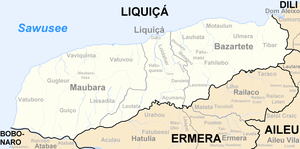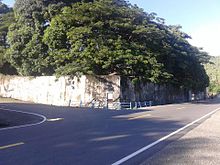Maubara (Administrative Office)
| Maubara Administrative Office | ||
|
|
||

|
||
| Administrative headquarters | Maubara | |
| surface | 268.99 km² | |
| population | 21,920 (2015) | |
| Sucos | Population (2015) | |
| Gugleur | 3,716 | |
| Guiço | 1,983 | |
| Lissadila | 4,559 | |
| Maubaralissa | 1,969 | |
| Vatuboro | 2,791 | |
| Vatuvou | 4,226 | |
| Vaviquinia | 2,676 | |
| Overview map | ||

|
||

|
||
Maubara ( Maubere ) is a osttimoresisches Office of Administration ( Portuguese Posto Administrativo ) in the municipality of Liquiçá . The seat of the administration is the place Maubara in Suco Vaviquinia .
geography
Until 2014, the administrative offices were still referred to as sub-districts . Before the 2015 territorial reform, Maubara had an area of 264.84 km². Now there are 268.99 km².
The Maubara administrative office forms the western part of the municipality of Liquiçá. To the west and north lies the Sawu Sea , to the east the Liquiçá administrative office and south, across the Lóis River , the Atabae ( municipality of Bobonaro ) and Hatulia ( municipality of Ermera ). East of it flows into the river Bahonu at Ponta Sia Ilo . Opposite is the Indonesian island of Alor .
Maubara is divided into seven sucos : Gugleur ( Guguleur ), Guiço ( Guico , Cuico ), Lissadila ( Lisadilia ), Maubaralissa ( Maubaralisa ), Vatuboro ( Vatoboro , Fatuboro ), Vatuvou and Vaviquinia ( Viviquinia ).
At Maubara you will find some of the few mangrove forests in Timor. Three kilometers east of the village Maubara is the salty Maubarasee ( Lago Maubara, Sia Maubara ), the many birds provides a habitat.
- Climate data
Residents
21,920 people live in the administrative office (2015), of which 11,181 are men and 10,739 women. The population density is 81.5 inhabitants / km². The largest language group are the speakers of the national language Tokodede . The average age is 19.7 years (2010, 2004: 19.5 years).
history
Maubara was one of the traditional kingdoms of Timor , ruled by a liurai . It appears on a list by Afonso de Castro , a former governor of Portuguese Timor who listed 47 empires in 1868. In 1667 the area of today's administrative office came under the influence of the Netherlands , who built a fort here in 1756 . It is right at the entrance to Maubara, from where you can see the entire bay on the beach. There are still old cannons in the well-preserved fortress today. During this time the Dutch in Maubara first planted coffee on Timor. In 1790 the Topasse ruler Pedro da Hornay attacked Maubara unsuccessfully on behalf of Portugal , with which he only succeeded in Maubara renewing his alliance with the Netherlands and setting the flag of the Netherlands . From 1796 to 1799 Maubara and Groß-Sonba'i were at war with the Portuguese.
In the Treaty of Lisbon in 1859, the Dutch agreed to cede Maubara to the Portuguese as part of a major exchange of territory. The handover took place in April 1861. It is speculated that Dom Carlos , the Liurai of Maubara, incited the empire of Ulmera to a rebellion against the Portuguese in 1861. Despite good persuasion from the Dutch, he had not come to terms with the new masters. The Ulmera rebellion was finally put down in September with the help of the Liurais loyal to the Portuguese.
In the spring of 1867 the Kemak from Lermean (today the municipality of Ermera) , who were under the sovereignty of Maubara, rose . Governor Francisco Teixeira da Silva put down the resistance in an unequal battle. In the decisive battle, which lasted 48 hours, the rebels had to defend themselves against a superior force that was superior to firepower. 15 villages were captured and burned down. The number of victims among the Timorese is not known, the Portuguese put their own casualties at two dead and eight wounded. The territory of Lermeans was divided among the neighboring kingdoms.

In 1893 Maubara himself, together with Atabae, revolted against the expansion of military and administrative control in Portugal. According to recent research, the Portuguese officer Francisco Duarte Maubara is said to have incited the rebellion, for which he initially lost his position. The Liurai attacked two Portuguese military posts in Dato and Vatuboro and tried to win the Dutch back as a protective power. As a result of the suppression of the uprising, cholera broke out in Maubara . In November the Liurai officially signed a written treaty with Portugal on Maubara's vassal status.
During the Second World War , Portuguese Timor was occupied by the Japanese . In Liquiçá and Maubara, the entire remaining Portuguese population was interned in camps from the end of October 1942 . The conditions in the camp were poor, food was scarce and the hygienic conditions inadequate due to a lack of water. Many Portuguese died because of it. Although there was a Portuguese doctor who was later assigned two Japanese doctors, there was a lack of medicine. During the first year Japanese soldiers guarded the camp, later Japanese Kempeitai , along with Timorese guards and spies.
During the civil war between UDT and FRETILIN in 1975, the people of Vaviquinia fled to the Indonesian West Timor for fear of violence .
Shortly afterwards, Indonesia began to occupy East Timor, which had just declared itself independent. In June 1976 Indonesian troops attacked Maubara. Here, too, there were massacres of the civilian population. In Maubara, FALINTIL founded the base de apoio Malehui, a resistance base that offered refuge for refugees from Maubara, Leimea-Craic , Railaco , Atsabe , Ainaro and Zumalai . The base was later destroyed by the Indonesians. At the end of 1979 there were so-called transit camps in Maubara, Lebumeta (Suco Vaviquinia) and Irlelo (Suco Guiço) , in which the occupiers interned East Timorese civilians. Between 1970 and 1980, the population in what was then the sub-district of Liquiçá fell from 14,610 to 11,450 by 21.6%.
In 1999, pro-Indonesian militias ( Wanra ) tried to use force to influence the mood ahead of the August 30 independence referendum . One of the most feared Wanra in East Timor, the Besi Merah Putih (BMP), comes from the village of Maubara , and was mainly forcibly recruited in this sub-district and also had its headquarters here. The BMP was already active from January 1999. She committed hundreds of crimes before the referendum and after the independence decision was announced. Many people fled for fear of the forced recruitment. On January 19, the BMP attacked Maubara, whereupon many residents fled to Leotala . On February 15, Vatuvou and Guiço and on February 23, Guiço, were attacked again by the BMP. Refugees from Guiço reported that all 400 families there had lost their homes and crops. Lissadila, Vatuvou and Maubaralissa became ghost towns . Its residents fled to Sare ( Ermera district ). There alone up to 6,000 refugees gathered (2,250 from Guiço alone) and stayed until the arrival of INTERFET in September 1999. Almost 2,700 refugees from Vatuvou and Maubara gathered in March in Gariana (Vatuvou), 375 at the Carmelite nuns in Lissadila.
On January 6, 2007, three women in Maubaralissa were accused of being witches. The women, aged 25, 50 and 70, were murdered and their houses set on fire. Three suspects were arrested by UN police. It was the first case of its kind in the predominantly Catholic East Timor.
politics
The administrator of the administrative office is appointed by the central government in Dili. In 2015 it was Laurindo dos R. da Silva .
economy
66% of households in Maubara grow coconuts, 69% corn, 62% cassava, 38% vegetables, 53% coffee and 7% rice. The latter is mainly grown on the Lóis River. Maubara is known as an attractive diving destination for divers .
- Silversmith in Maubara
Personalities
- Faustino da Costa (* 1974), policeman
Web links
supporting documents
- Geoffrey C. Gunn: History of Timor - Technical University of Lisbon (PDF file; 805 kB)
Individual evidence
- ↑ a b c d e Direcção-Geral de Estatística : Results of the 2015 census , accessed on November 23, 2016.
- ↑ Jornal da República : Diploma Ministerial no 24/2014 de 24 de Julho - Orgânica dos Postos Administrativos ( Memento of March 4, 2016 in the Internet Archive )
- ↑ a b Direcção Nacional de Estatística: 2010 Census Wall Chart (English) ( Memento of the original from August 12, 2011 in the Internet Archive ) Info: The archive link was automatically inserted and not yet checked. Please check the original and archive link according to the instructions and then remove this notice. (PDF; 2.5 MB)
- ↑ a b Seeds of Life
- ↑ Direcção Nacional de Estatística: Census of Population and Housing Atlas 2004 ( Memento of November 13, 2012 in the Internet Archive ) (PDF file; 13.3 MB)
- ↑ TIMOR LORO SAE, Um pouco de história ( Memento of the original dated November 13, 2001 in the Internet Archive ) Info: The archive link was inserted automatically and has not yet been checked. Please check the original and archive link according to the instructions and then remove this notice.
- ↑ East Timor - PORTUGUESE DEPENDENCY OF EAST TIMOR ( Memento of February 21, 2004 in the Internet Archive )
- ↑ Gunn p. 50
- ↑ Fernando Augusto de Figueiredo: Timor. A presença portuguesa (1769–1945) (PDF file; 66.2 MB)
- ↑ Chronologie de l'histoire du Timor (1512–1945) suivie des événements récents (1975–1999) (French; PDF file; 867 kB)
- ^ Gunn p. 86
- ^ The case of Alferes Francisco Duarte “O Arbiru” (1862–1899) (PDF; 386 kB), accessed on March 25, 2013
- ↑ a b c "Chapter 7.3 Forced Displacement and Famine" (PDF; 1.3 MB) from the "Chega!" Report of the CAVR (English)
- ↑ "Part 3: The History of the Conflict" (PDF; 1.4 MB) from the "Chega!" Report of the CAVR (English)
- ↑ ABC news, January 10, 2007, Three suspects arrested for killing of Timorese "witches" ( Memento of January 13, 2007 in the Internet Archive )
- ↑ Ministério da Administração Estatal: Administração Municipal ( Memento of the original from June 1, 2016 in the Internet Archive ) Info: The archive link has been inserted automatically and has not yet been checked. Please check the original and archive link according to the instructions and then remove this notice.
- ↑ Direcção Nacional de Estatística: Suco Report Volume 4 (English) ( Memento of the original from April 9, 2015 in the Internet Archive ) Info: The archive link was inserted automatically and has not yet been checked. Please check the original and archive link according to the instructions and then remove this notice. (PDF file; 9.4 MB)
- ^ Underwater Photography East Timor
Coordinates: 8 ° 37 ′ S , 125 ° 12 ′ E











